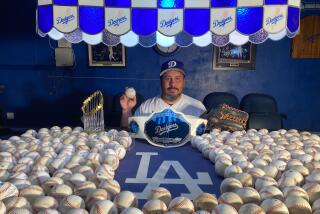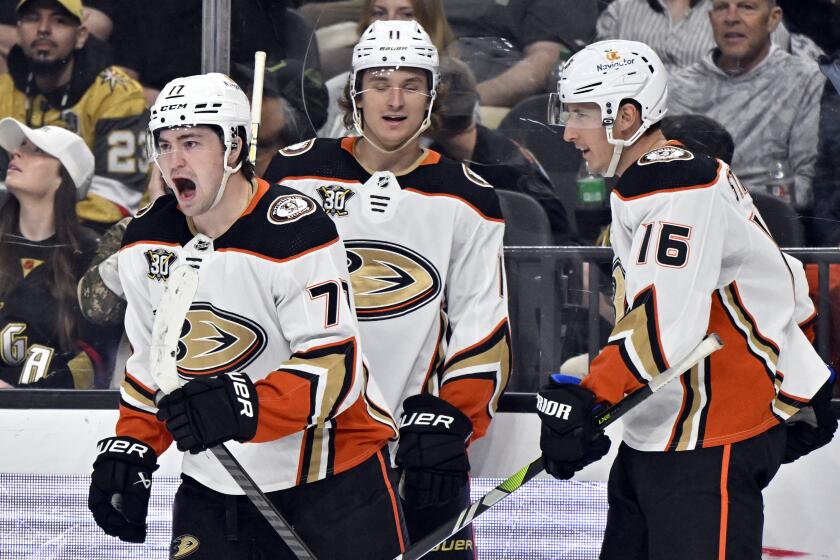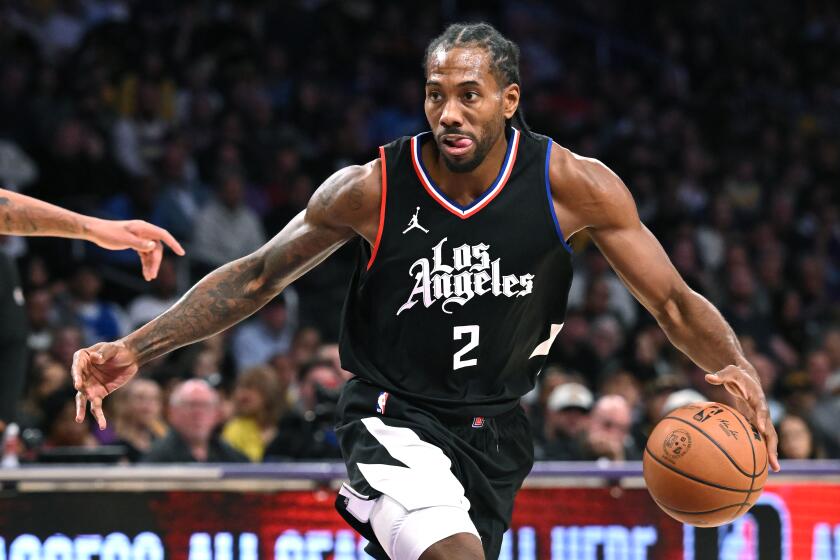LOSING THE RACE
As he walked through the airport in Atlanta on his way to catch a flight to Jacksonville, Fla., to see the Super Bowl, Charlie Sifford was stopped in his tracks by a man who stared at him for a few moments.
“You play golf?”
Sifford said he did.
“You Charlie Sifford?”
Sifford said he was.
“I thought that was you. Where’s your cigar?”
That happens all the time, Sifford said, people figuring out who he is and asking about his trademark cigar. Sure, the cigar. It’s what he stands for now, at least in public, his prop, the key portion of the recognition factor.
But if that’s how we know Sifford these days, then golf history is just a puff of smoke, circling around our heads, then disappearing. With the Nissan Open being played this week at Riviera Country Club, it’s a noteworthy date -- the 36th anniversary of Sifford’s victory in the tournament’s predecessor, the Los Angeles Open.
Sifford was already a winner, only not in places where most people could see him. He won the Negro Open five consecutive years when a “Caucasians Only” clause kept him off the PGA Tour until 1961. And now, 44 years after he became the first African American to play on the men’s pro golf tour, is this his legacy?
After Sifford broke the color barrier on tour, several other African Americans soon launched successful professional careers, such players as Lee Elder, Jim Thorpe, Calvin Peete and Pete Brown. When Sifford won in L.A., there were five other African Americans in the field.
Today? There is one African American playing on the PGA Tour, and his name is Tiger Woods. But even Woods’ status as one of the world’s most visible athletes so far has done little to change the racial makeup of professional golf.
Sifford, 82, whose 1992 autobiography was titled “Just Let Me Play,” knows how difficult it is for African American golfers to reach the top level of the sport.
“You know how tough it is, man? It’s just so hard to get there,” he said. “These local kids don’t have no place to practice, they’re taught basketball, that’s where they see the money going, and football.
“I think Tiger’s done a wonderful job with his foundation and clinics, but there’s so much more work to be done. Sure, I might have proved something, but I’m glad I’m not out there playing now.”
Sifford’s legacy includes a 1967 victory at the Greater Hartford Open when he closed with a 64, thus becoming the first African American to win a PGA Tour event. Plus, there’s his victory in 1969 at Rancho Park, where he shot a 28 on the front nine on the last day, then his 1975 PGA Seniors Championship and his induction in November as the first African American member of the World Golf Hall of Fame.
He wasn’t always welcomed on the trail he cleared in pro golf. At Phoenix, feces were left in his drinking cup. He got threatening phone calls at night, suggesting he shouldn’t show up the next day. Fans kicked his ball from the fairway into the rough.
“Charlie’s induction reminds us how far we have come as a country and a game,” PGA Tour Commissioner Tim Finchem said. “But it also reminds us how far we have to go.”
Certainly one portion of Sifford’s legacy is lacking -- the participation of African Americans in the pro ranks. Woods, whose ethnic makeup is primarily African American and Asian as well as Native American and Caucasian, is the only African American on the PGA Tour. Tim O’Neal represents his race on the Nationwide Tour, and there are no African Americans on the LPGA Tour.
More than eight years after Woods turned pro in his celebrated “Hello World” campaign that included a message that there were courses he could not play because of the color of his skin, no African American has followed him to the PGA Tour. There must be another message here, and there are more than a few prepared to deliver it.
“I’m very surprised, man, and I don’t know what we have to do,” said Thorpe, 56, who joined the PGA Tour in 1976. The ninth of 12 children born to a greenskeeper at a nine-hole course in Roxboro, N.C., Thorpe plays on the Champions Tour but is concerned about the regular tour and the face of America that is not being seen.
Thorpe said young African Americans see high schoolers make million-dollar contracts with the NBA.
“But they don’t see that stuff in golf,” he said. “There’s only one like them, Tiger. It can’t be that easy if he’s the only one doing it, right?
“Calvin Peete, Charlie and Lee Elder and I have all talked about this. We don’t understand. Yes, we know it’s a very expensive game, the venues are not cheap, and the equipment is not cheap. Most African American parents who do have kids don’t live in country clubs.”
Thorpe also said the elimination of caddie programs and the rising use of carts have cut down on playing opportunities.
“If we weren’t caddying, we were playing,” he said. “Those kind of things, they don’t exist anymore.”
The so-called “Caucasian Only” rule kept African Americans out of pro golf, until Sifford and former California Atty. Gen. Stanley Mosk forced the PGA to drop its race clause and allow African Americans onto the same playing field.
“I thank God every day for what Charlie Sifford did,” Thorpe said.
There were others before him, players such as Bill Spiller and Teddy Rhodes, but it was Sifford who broke the line.
Meanwhile, that line has thinned out.
Tim O’Neal was in Panama recently, playing a tournament on the developmental Nationwide Tour. He missed the cut, but O’Neal is accustomed to setbacks. In 1999, he needed only a bogey on the last hole to win his PGA Tour card at qualifying school but made a triple bogey instead. He came back in December and fell one shot short, missing a 10-foot birdie putt on his last hole.
A former state Georgia Amateur champion and a star at Jackson State, O’Neal said he has raised expense money himself, about $50,000, to keep his dream alive. He said getting to the PGA Tour really isn’t about race anyway.
“It just breaks down to playing golf,” O’Neal said. “It’s hard for everybody. It seems like the few minority players who are around have the ability to play; there just aren’t many of them.
“I think that 10-15 years down the road, it’ll be different, but I don’t see it happening right now. It’s easier to play basketball or baseball or football than to go to a golf course, have to buy balls and clubs and pay green fees.”
Eddie Payton, the Jackson State coach, said O’Neal has a huge upside.
“He just needs a break,” Payton said. “He’s got the intangibles; he’s special. Oh, man, he’s got a swing that would make you want to divorce your wife and marry him, it’s so sweet.”
At 31, O’Neal has traveled the less-than-glittery side of golf’s minor leagues, the mini-tours such as the Hooters, the Golden Bear and the Maverick tours.
“Frustrating? Sometimes,” he said. “I’ve been close twice now. I’ve just got to go on chasing my dream. That’s what I’ve done. And I’m still chasing it.”
There are programs in place to provide golf help for African Americans like O’Neal when they are younger, but these initiatives are relatively new or small in scope. The American Junior Golf Assn., based near Atlanta, has programs in 50 states, but only 5,000 kids nationwide take part.
Steve Hamblin, the executive director, said he does not know how many in his membership are African American because that question is not asked on the entry forms. As for prominent African Americans who have taken part in the AJGA, Hamblin mentioned Josh Wooding at Stanford and Cheyenne Woods, 14, the niece of Tiger Woods.
“I don’t have great numbers, but the African American players we have seen are talented.”
Hamblin said AJGA enrollment spiked when Woods appeared on the scene, but it has dipped recently. The so-called Tiger effect means something different to Hamblin than the race issue.
“What he did was more than just racial,” Hamblin said. “He made golf cool. Before, if you played golf, you were a nerd. It was for non-athletes. That’s not what he was.
“Then you’ve got programs like the First Tee, and you’ve got to give them a little time. I know they say they’re not trying to develop players, just introduce them to the game, but if you do that enough times, somebody is going to shake out, I think.”
Operational since 2000, the First Tee is an initiative of the World Golf Foundation based in Florida and is supported by most of golf’s establishment, such as the PGA Tour, LPGA Tour, PGA of America, United States Golf Assn. and the Masters tournament.
Joe Louis Barrow, executive director of the First Tee, said more than 450,000 young people at 200 learning facilities in 39 states have been introduced to golf through the program. But the business model of the First Tee is more about teaching golf’s core values to young people that they may use them in the vocation they choose, than it is about moving on to golf’s higher levels.
“The skill sets you learn from golf will serve you well whether you become a teacher, doctor, lawyer, politician or an executive in business,” Barrow said.
“The values associated with the game -- discipline, persistence, desire, drive, honesty -- the more kids are playing the game of golf, that’s what they learn. Whether they have that talent, discipline, persistence, desire and drive and take it with them from high school to college to the pros, that’s obviously up to the young person.”
Barrow, the son of legendary boxer Joe Louis, says he is often asked when kids from the First Tee will move on to the pros.
“I just tell them what Earl Woods told me. He said, ‘It took me 22 years to get Tiger where he was.’ The First Tee was just announced in 1997 and firmly in place in 2000, so give them some time.”
As for Tiger, his Tiger Woods Foundation is building a 35,000-square-foot learning center in Anaheim with an emphasis more on educational support than building pro golfers.
“We want to introduce the game to kids who otherwise wouldn’t be exposed, but we’ve not taken the position of creating the next Tiger Woods,” said Greg McLaughlin, executive director of the foundation.
“But at the same time, personally, I am surprised just in general that there aren’t more African American golfers playing at the professional level. If 12% of our population is African American, why isn’t there a like percentage playing the pro golf tour? That, to me, is surprising, especially since the world’s most famous athlete and the sport’s greatest player is a person of color.”
In Jackson, Miss., Payton, older brother of the late running back Walter Payton, has become outspoken on the issue. Even at the predominantly black university, Payton has only two African Americans among his first five players, so he isn’t really shocked that Woods is the only African American on the PGA Tour.
“Not when you look at the history of African Americans on tour, there’s basically only been one per generation, you paint him the role model,” Payton said. “Tiger has done a great job making golf a cool sport, but that’s not addressing our core problem.
“We don’t have a development system after these kids have been identified with talent at an early age so they can be taken to the next level, to college to pro. We don’t have the mechanics in place to bring that kid through the system. As a race of people, we have not done that. You’ve got a lot more people saying more than doing.”
One of the problems is the lack of follow-up, Payton said. He said some inner-city kids go to a clinic, they’re given a ball, a club, hit some shots and then the instructors don’t come back for a year.
“Where do these kids go after we’ve introduced them?” he said. “It’s like this. You give a kid an H2 Hummer and leave. It’ll just sit there to the next year until they figure out how to crank it up.”
Payton calls for interest from the minority community to fund and staff after-school and weekend programs with qualified instructors. Besides learning the nuances and techniques of golf, plus its rules and history, Payton said the instructors would provide fundamental training and guidance.
It’s an ambitious idea, but there is no time to waste, he said.
“We’ve already got generations where we have one African American representative out there. Tiger is one. Tim O’Neal is one. At the rate we’re going, when the Champions Tour players retire, we’re not going to have any on that tour. None in the LPGA....
“What’s wrong with this picture? We, as a race, are missing the boat if we step back and allow this to happen. Because what they’re saying is that we can’t teach our kids.”
And Sifford, with his trademark cigar, said he was ready to talk about it as much as anybody. He has another mission, one he’s ready to tackle. He knows it’s important.
“It gets my blood pressure up.”
*
(BEGIN TEXT OF INFOBOX)
Times have changed
How the six African Americans who played in the Los Angeles Open in 1969 finished. This year, Tiger Woods is the only player of African American descent scheduled to play in the Nissan Open:
276, first ($20,000)
Charlie Sifford...63-71-71-71
286, tied for 34th ($530)
Ray Botts...72-71-73-70
Jimmy Walker...67-71-73-75
287, tied for 40th ($361)
Pete Brown...69-73-73-72
Did not make cut -- Lee Elder and Curtis Sifford
Los Angeles Times
More to Read
Get our high school sports newsletter
Prep Rally is devoted to the SoCal high school sports experience, bringing you scores, stories and a behind-the-scenes look at what makes prep sports so popular.
You may occasionally receive promotional content from the Los Angeles Times.






